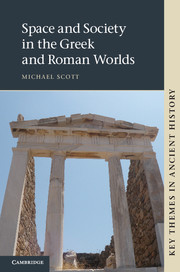Book contents
- Frontmatter
- Contents
- Illustrations
- Acknowledgements
- Abbreviations
- Introduction
- Chapter 1 Inheriting and articulating a community
- Chapter 2 Networks of polytheism: spaces for the gods at Delos
- Chapter 3 Spaces of alienation: street-lining Roman cemeteries
- Chapter 4 A spatial approach to relationships between colony and metropolis
- Chapter 5 The place of Greece in the oikoumene of Strabo’s Geography
- Conclusion: space and society in the Greek and Roman worlds
- Bibliographic essay
- Bibliography
- Index
Conclusion: space and society in the Greek and Roman worlds
Published online by Cambridge University Press: 05 December 2012
- Frontmatter
- Contents
- Illustrations
- Acknowledgements
- Abbreviations
- Introduction
- Chapter 1 Inheriting and articulating a community
- Chapter 2 Networks of polytheism: spaces for the gods at Delos
- Chapter 3 Spaces of alienation: street-lining Roman cemeteries
- Chapter 4 A spatial approach to relationships between colony and metropolis
- Chapter 5 The place of Greece in the oikoumene of Strabo’s Geography
- Conclusion: space and society in the Greek and Roman worlds
- Bibliographic essay
- Bibliography
- Index
Summary
Introduction
The case-studies examined over the previous chapters have sought to illustrate not just the variety of forms a spatial approach can take but also the kinds of advantages and insights such approaches can offer for the study of the ancient world. In Chapter 1, in response to spatial scholarship that has not recently been focused on agora-type civic space, and to scholarship on Cyrene that has focused on the city’s turbulent political history so often constructed through sources from other places and times, I investigated the spatial development of particular structures within the city’s agora. This chapter thus not only provided a way into understanding Cyrene’s political development from a Cyrenean perspective but also offered a detailed window on the way that change was formulated, negotiated and perceived over time as well as the way in which, and the key moments during which, the agora space was developed and utilised in comparison to other types of space within the city (cf. Figures 1.1, 1.9).
The focus in Chapter 2 moved from civic space to sacred space and from individual structures to the relationships between spaces for the gods on Delos. In response to scholarship on Delos’ wide pantheon that so often focused on the literary and epigraphical evidence, a spatial approach to how its multiple networks of polytheism developed on the ground over time was adopted in order to provide a crucial counter-vantage point from which to understand the changing experience of the sanctuary as well as its role in the wider world. That investigation highlighted not just the range of motivations behind spatial placement but also the range of types of relationships constructed between divinities as a result, as well as the way in which those relationships continued to change over time (cf. Figures 2.1, 2.2, 2.10). Crucially, it also underlined the reciprocal relationship between epigraphic, literary and archaeological evidence, by showing the ways in which the networks of polytheism presented by each could reinforce, contradict or complement one another.
- Type
- Chapter
- Information
- Space and Society in the Greek and Roman Worlds , pp. 159 - 169Publisher: Cambridge University PressPrint publication year: 2012



